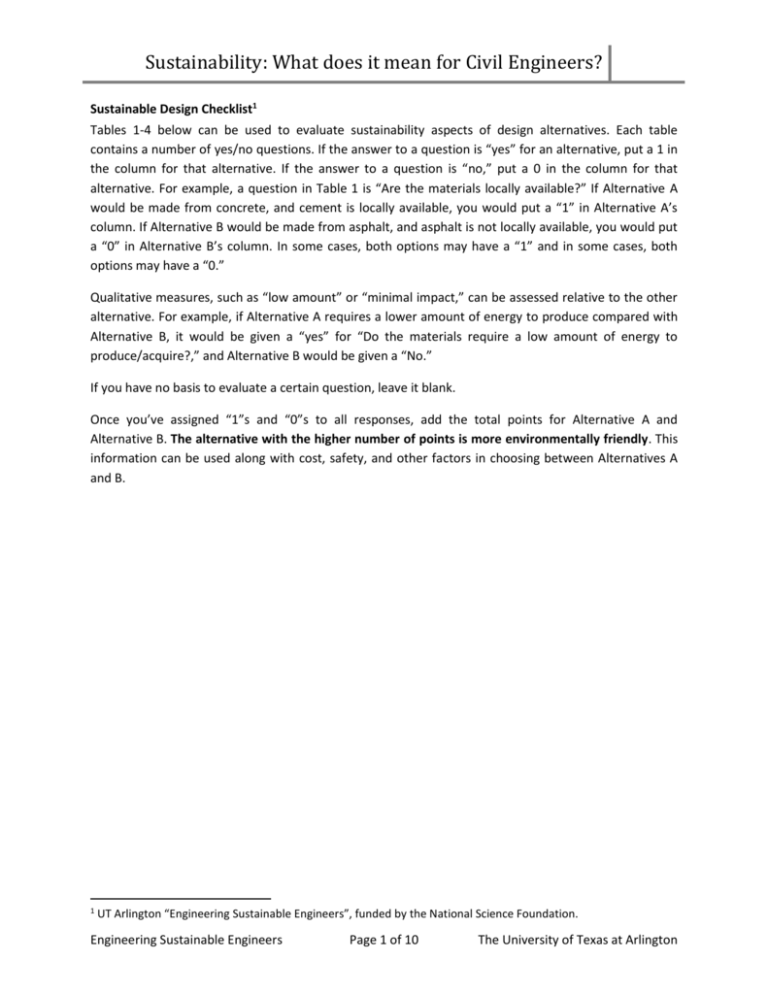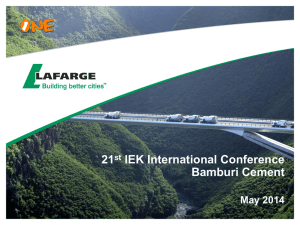Sustainability: What does it mean for Civil Engineers?
advertisement

Sustainability: What does it mean for Civil Engineers? Sustainable Design Checklist1 Tables 1-4 below can be used to evaluate sustainability aspects of design alternatives. Each table contains a number of yes/no questions. If the answer to a question is “yes” for an alternative, put a 1 in the column for that alternative. If the answer to a question is “no,” put a 0 in the column for that alternative. For example, a question in Table 1 is “Are the materials locally available?” If Alternative A would be made from concrete, and cement is locally available, you would put a “1” in Alternative A’s column. If Alternative B would be made from asphalt, and asphalt is not locally available, you would put a “0” in Alternative B’s column. In some cases, both options may have a “1” and in some cases, both options may have a “0.” Qualitative measures, such as “low amount” or “minimal impact,” can be assessed relative to the other alternative. For example, if Alternative A requires a lower amount of energy to produce compared with Alternative B, it would be given a “yes” for “Do the materials require a low amount of energy to produce/acquire?,” and Alternative B would be given a “No.” If you have no basis to evaluate a certain question, leave it blank. Once you’ve assigned “1”s and “0”s to all responses, add the total points for Alternative A and Alternative B. The alternative with the higher number of points is more environmentally friendly. This information can be used along with cost, safety, and other factors in choosing between Alternatives A and B. 1 UT Arlington “Engineering Sustainable Engineers”, funded by the National Science Foundation. Engineering Sustainable Engineers Page 1 of 10 The University of Texas at Arlington Sustainability: What does it mean for Civil Engineers? Table 1. MATERIALS PRODUCTION/ACQUISITION Sustainability Metric a. Material use Yes/No Questions Alt. A Alt. B Does the design utilize recycled or reclaimed materials? Does the design utilize renewable resources (i.e. wood)? b. Energy use Do the materials require a low amount of energy to produce/acquire? Are the materials locally available, minimizing energy needed for transport? c. Water use Do the materials require a low amount of water to produce/acquire? d. Solid waste generation Does material production/acquisition produce a low amount of solid waste? e. Emissions generation Does materials production produce a low amount of air pollution emissions? f. Toxic releases Is the material non-toxic, which would generally lower the potential for toxic releases? g. Land Impact Does material production/acquisition and transport produce minimal impact on plants, animals, and ecosystems? Other Specify: TOTAL Points Yes = 1, No = 0 Engineering Sustainable Engineers Page 2 of 10 The University of Texas at Arlington Sustainability: What does it mean for Civil Engineers? Table 2. CONSTRUCTION Sustainability Metric a. Material use b. Energy use Yes/No Questions Alt. A Alt. B N/A Are construction techniques chosen to minimize energy use? Is the construction equipment energy efficient? c. Water use Does the construction process require a low amount of water? d. Solid waste generation Does the construction process produce a low amount of solid waste that must be landfilled? e. Emissions generation Does the construction equipment have air pollution controls or use alternate fuels? Are particulate control measures (such as watering exposed soil) used during the construction process? Are low VOC paints, adhesives, and cleaners used in the construction process? f. Toxic releases g. Land Impact N/A Other Specify: Does the construction site have stormwater pollution controls, such as silt fences? TOTAL Points Yes = 1, No = 0 Engineering Sustainable Engineers Page 3 of 10 The University of Texas at Arlington Sustainability: What does it mean for Civil Engineers? Table 3. USE Sustainability Metric a. Material use b. Energy use Yes/No Questions Alt. A Alt. B Will maintenance require a low amount of materials? Does the design use less energy than alternatives, via insulation, energy efficient lighting, etc.? Does the design use renewable energy, like solar? c. Water use Does the design use less water than alternatives? Does the design avoid producing water pollution? d. Solid waste generation Does the design have a longer lifespan than alternatives? Does the design produce a low amount of solid waste during use? e. Emissions generation Will the use generate a low amount of air pollutant emissions? f. Toxic releases Will the use generate toxic pollutants that will be emitted into the air? g. Land Impact Will the use generate toxic pollutants that will be discharged into the water? Will the design use a low amount of land space? Does the design minimize impervious cover/pavement? Does the design minimize stormwater runoff and pollution, and avoid exacerbating flooding? Does the design produce minimal impacts on plants, animals, and ecosystems? Other Specify: TOTAL Points Yes = 1, No = 0 Engineering Sustainable Engineers Page 4 of 10 The University of Texas at Arlington Sustainability: What does it mean for Civil Engineers? Table 4. DEMOLITION Sustainability Metric a. Material use b. Energy use c. Water use d. Solid waste generation Yes/No Questions Alt. A Alt. B N/A N/A Are the materials recyclable or re-usable? Can different kinds of materials be easily separated for recycling/re-use? Will demolition produce a low amount of solid waste? e. Emissions generation f. Toxic releases Will demolition generate a low amount of air pollutant emissions? Will the waste generated contain hazardous substances that could pollute landfill leachate? g. Land Impact Other N/A Specify: TOTAL Points Yes = 1, No = 0 Table 5. ALTERNATIVE POINT SUMMARY Number of Points Alt. A Number of Points Alt. B Table 1 Table 2 Table 3 Table 4 TOTAL Engineering Sustainable Engineers Page 5 of 10 The University of Texas at Arlington Sustainability: What does it mean for Civil Engineers? Homework Assignment: Materials Selection Using the Sustainable Design Checklist You are an engineer charged with deciding between asphalt concrete (AC) and continuously reinforced Portland cement concrete (CRPCC) for an arterial roadway surface. You’ve already done most of your evaluation (costs, safety, etc.); the environmental evaluation remains. **Note: In some cases, data is presented for engineered cementious concrete (ECC), but you may ignore that option in this analysis. Also note that the materials acquisition and construction are presented as two separate phases. Using Tables 1-4 above, the information given below, compare the environmental impacts of asphalt concrete vs. Portland cement concrete. Asphalt, a component of crude petroleum, is used as a glue or binder for aggregate particles. Asphalt pavement (or asphalt concrete) is typically 5% asphalt cement binder and 95% aggregates. Portland cement, mixed with water, is used to bind aggregate together to form cement concrete. Typically, around 20% cement and water is mixed with 80% aggregate. Materials Acquisition/Production Phase A comparison of the materials used in asphalt concrete and continuously reinforced Portland cement concrete are shown below. Pavement Type Asphalt concrete Material Components Aggregates (sand, gravel, and/or crushed stone) Asphalt binder Aggregates (sand, gravel, and/or crushed stone) Portland cement Continuously reinforced concrete (Portland cement concrete) Water Steel rebar Raw Materials Rock, sand Crude oil Rock, sand Iron ore, shale, clay, limestone, gypsum Water Steel scrap Although crude petroleum is a non-renewable resource, asphalt can be recycled. In fact, asphalt road surface is the most widely recycled material in the US, both by gross tonnage and by percentage. According to the Federal Highway Administration and Environmental Protection Agency, 80% of the asphalt from road surfaces that is removed each year during widening and resurfacing projects is reused as part of new roads, roadbeds, shoulders and embankments. Cement is made by heating limestone (calcium carbonate), with small amounts of other materials (such as clay, iron ore, or shale) to a very high temperature, 1450°C, in a kiln. The resulting hard substance, called “clinker”, is then ground with a small amount of gypsum into a powder to make Portland Cement, the most commonly used type of cement. Heating the limestone in the kiln requires a substantial amount of energy, and also releases carbon dioxide (CO2), a greenhouse gas, from the calcium carbonate. In fact, the cement industry produces about 5% of global anthropogenic CO2 emissions, of which 50% is from the chemical process, and 40% Engineering Sustainable Engineers Page 6 of 10 The University of Texas at Arlington Sustainability: What does it mean for Civil Engineers? from burning fuel. Most cement kilns today burn coal and petroleum coke as primary fuels (which are non-renewable resources), although they can also burn waste materials, such as shredded tires. The amount of CO2 emitted by the cement industry is nearly 900 kg of CO2 for every 1000 kg of cement produced. Asphalt and Portland cement concrete can incorporate recycled materials. Cement can contain up to 30% fly ash from coal-fired utility boilers and other sources. It is estimated that around 75% of Portland Concrete Cement pavements is recycled, and 45% of steel rebar used in reinforced concrete is recycled. Reinforcing steel is produced almost entirely from steel scrap. Dust and noise result from quarrying for limestone to make Portland cement. Removal of vegetation from the quarry surface is an additional environmental impact. According to a study by Rajendran and Gambatese (2007), asphalt concrete generates more solid waste during the materials acquisition/production phase compared with Portland cement concrete. Construction Phase According to a study by Rajendran and Gambatese (2007), CRPCC produces more solid waste during the construction phase, compared with AC. According to a study by Zapata and Gambatese (2005), constructing PCC roadways uses more energy than constructing AC roadways. The table below compares the energy and time requirements (in hours) for equipment used in the construction of concrete, engineered cementious concrete (ECC) and hot mix asphalt (HMA) surfaces. 2 2 Source: Zhang, Han (2009). “Sustainable Pavement Asset Management Based on Life Cycle Models and Optimization Methods”. Available online: http://css.snre.umich.edu/css_doc/CSS09-14.pdf. Engineering Sustainable Engineers Page 7 of 10 The University of Texas at Arlington Sustainability: What does it mean for Civil Engineers? Use Phase Maintenance and operation of PCC and AC roadways uses about equal amounts of energy. Some studies suggest that AC pavements have longer lives, while other studies suggest that CRC pavements have longer lives. The figure below provides one comparison of maintenance schedules for concrete, ECC and HMA overlays. 3 Asphalt releases bitumen fumes, which contain volatile organic compounds, particularly polycyclic aromatic hydrocarbons, which can be harmful to human health. Demolition Asphalt concrete generates more solid waste during the demolition phase compared with continuously reinforced Portland cement concrete (Rajendran and Gambatese, 2007). 3 Source: Zhang, Han (2009). “Sustainable Pavement Asset Management Based on Life Cycle Models and Optimization Methods”. Available online: http://css.snre.umich.edu/css_doc/CSS09-14.pdf. Engineering Sustainable Engineers Page 8 of 10 The University of Texas at Arlington Sustainability: What does it mean for Civil Engineers? All Stages The figures below show estimated (1) energy consumption, (2) emissions of common air pollutants and (3) water pollutant discharges for concrete, ECC and HMA during each life cycle stage. 4 (1): Energy Consumption Figure (2): Air Pollutant Emissions 4 Source: Zhang, Han (2009). Engineering Sustainable Engineers Page 9 of 10 The University of Texas at Arlington Sustainability: What does it mean for Civil Engineers? Figure (3): Water Pollutant Discharges Engineering Sustainable Engineers Page 10 of 10 The University of Texas at Arlington









